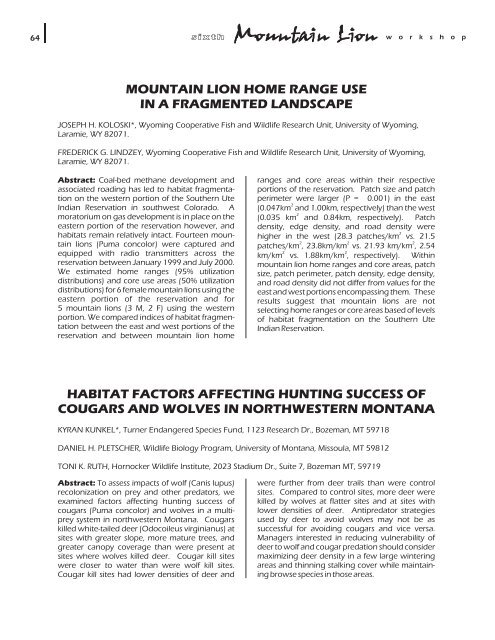PWD BK W7000-893 Proceedings.CDR - Mountain Lion Foundation
PWD BK W7000-893 Proceedings.CDR - Mountain Lion Foundation
PWD BK W7000-893 Proceedings.CDR - Mountain Lion Foundation
You also want an ePaper? Increase the reach of your titles
YUMPU automatically turns print PDFs into web optimized ePapers that Google loves.
64<br />
sixth <strong>Mountain</strong> <strong>Lion</strong> w o r k s h o p<br />
MOUNTAIN LION HOME RANGE USE<br />
IN A FRAGMENTED LANDSCAPE<br />
JOSEPH H. KOLOSKI*, Wyoming Cooperative Fish and Wildlife Research Unit, University of Wyoming,<br />
Laramie, WY 82071.<br />
FREDERICK G. LINDZEY, Wyoming Cooperative Fish and Wildlife Research Unit, University of Wyoming,<br />
Laramie, WY 82071.<br />
Abstract: Coal-bed methane development and<br />
associated roading has led to habitat fragmentation<br />
on the western portion of the Southern Ute<br />
Indian Reservation in southwest Colorado. A<br />
moratorium on gas development is in place on the<br />
eastern portion of the reservation however, and<br />
habitats remain relatively intact. Fourteen mountain<br />
lions (Puma concolor) were captured and<br />
equipped with radio transmitters across the<br />
reservation between January 1999 and July 2000.<br />
We estimated home ranges (95% utilization<br />
distributions) and core use areas (50% utilization<br />
distributions) for 6 female mountain lions using the<br />
eastern portion of the reservation and for<br />
5 mountain lions (3 M, 2 F) using the western<br />
portion. We compared indices of habitat fragmentation<br />
between the east and west portions of the<br />
reservation and between mountain lion home<br />
ranges and core areas within their respective<br />
portions of the reservation. Patch size and patch<br />
perimeter were larger (P = 0.001) in the east<br />
2<br />
(0.047km and 1.00km, respectively) than the west<br />
2<br />
(0.035 km and 0.84km, respectively). Patch<br />
density, edge density, and road density were<br />
2<br />
higher in the west (28.3 patches/km vs. 21.5<br />
2 2 2<br />
patches/km , 23.8km/km vs. 21.93 km/km , 2.54<br />
2 2<br />
km/km vs. 1.88km/km , respectively). Within<br />
mountain lion home ranges and core areas, patch<br />
size, patch perimeter, patch density, edge density,<br />
and road density did not differ from values for the<br />
east and west portions encompassing them. These<br />
results suggest that mountain lions are not<br />
selecting home ranges or core areas based of levels<br />
of habitat fragmentation on the Southern Ute<br />
Indian Reservation.<br />
HABITAT FACTORS AFFECTING HUNTING SUCCESS OF<br />
COUGARS AND WOLVES IN NORTHWESTERN MONTANA<br />
KYRAN KUNKEL*, Turner Endangered Species Fund, 1123 Research Dr., Bozeman, MT 59718<br />
DANIEL H. PLETSCHER, Wildlife Biology Program, University of Montana, Missoula, MT 59812<br />
TONI K. RUTH, Hornocker Wildlife Institute, 2023 Stadium Dr., Suite 7, Bozeman MT, 59719<br />
Abstract: To assess impacts of wolf (Canis lupus)<br />
recolonization on prey and other predators, we<br />
examined factors affecting hunting success of<br />
cougars (Puma concolor) and wolves in a multiprey<br />
system in northwestern Montana. Cougars<br />
killed white-tailed deer (Odocoileus virginianus) at<br />
sites with greater slope, more mature trees, and<br />
greater canopy coverage than were present at<br />
sites where wolves killed deer. Cougar kill sites<br />
were closer to water than were wolf kill sites.<br />
Cougar kill sites had lower densities of deer and<br />
were further from deer trails than were control<br />
sites. Compared to control sites, more deer were<br />
killed by wolves at flatter sites and at sites with<br />
lower densities of deer. Antipredator strategies<br />
used by deer to avoid wolves may not be as<br />
successful for avoiding cougars and vice versa.<br />
Managers interested in reducing vulnerability of<br />
deer to wolf and cougar predation should consider<br />
maximizing deer density in a few large wintering<br />
areas and thinning stalking cover while maintaining<br />
browse species in those areas.
















